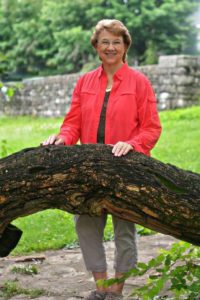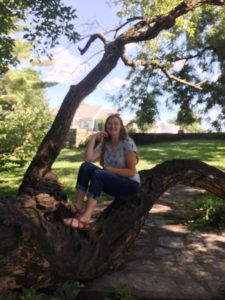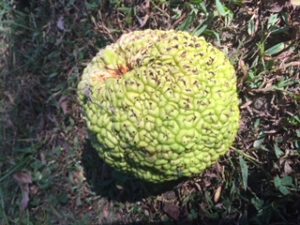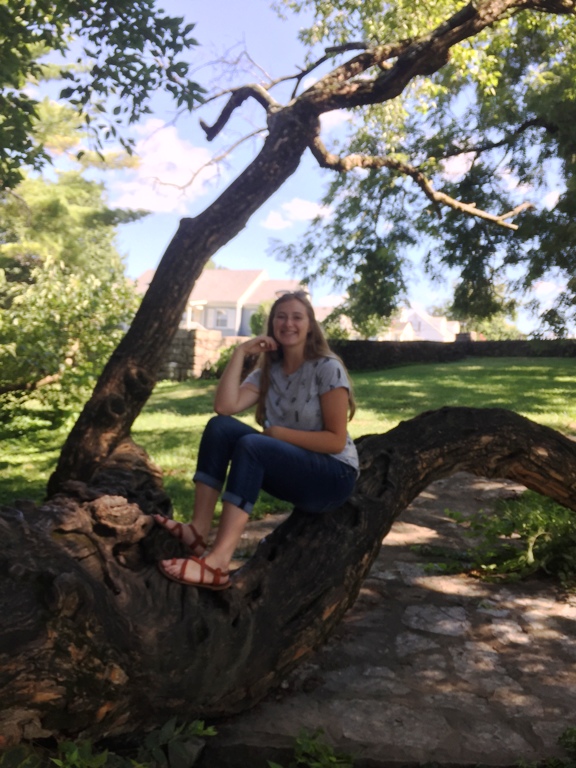
Fort Harrod, the first pioneer settlement in Kentucky in 1774, has been reconstructed as a history park in Harrodsburg, Kentucky. You can go tour the fort and see how those first pioneers lived. There’s a picnic area in front of the fort where the unofficial largest Osage orange tree in the county is located. It isn’t the officiaI largest tree (that’s in Virginia) because the Kentucky tree’s trunk is split. But official or unofficial, it’s an amazing tree that has been a playground for kids for generations and a photo op waiting to happen for many.
 I did a photo shoot last week to get a new author photo and the first place the photographer suggested was Fort Harrod’s Osage orange tree. Just last year I visited Fort Harrod with my son’s family and of course, we had to go check out the tree and take some pictures too.
I did a photo shoot last week to get a new author photo and the first place the photographer suggested was Fort Harrod’s Osage orange tree. Just last year I visited Fort Harrod with my son’s family and of course, we had to go check out the tree and take some pictures too.
 Thinking about all the pictures that have been taken of that tree and with that tree as a photo prop made me curious. I discovered that Osage orange trees are native to a small area in eastern Texas, southeastern Oklahoma, and southwestern Arkansas, a region that was the home of the Osage Indians. That’s where the tree got its name. The tree was easy to transplant and managed to live in poor soil, wasn’t bothered by heat and wind, insects or disease. Prior to the invention of barbed wire, many midwesterners planted it as a living fence. They would prune it into a hedge and no livestock would go through it because of its wicked thorns. The wood is also extremely hard and is favored for archery bows. You can also make a bright yellow die from the wood.
Thinking about all the pictures that have been taken of that tree and with that tree as a photo prop made me curious. I discovered that Osage orange trees are native to a small area in eastern Texas, southeastern Oklahoma, and southwestern Arkansas, a region that was the home of the Osage Indians. That’s where the tree got its name. The tree was easy to transplant and managed to live in poor soil, wasn’t bothered by heat and wind, insects or disease. Prior to the invention of barbed wire, many midwesterners planted it as a living fence. They would prune it into a hedge and no livestock would go through it because of its wicked thorns. The wood is also extremely hard and is favored for archery bows. You can also make a bright yellow die from the wood.
 Oddly enough, I had never connected that Osage orange tree at the fort with what we always called hedge apple trees. While we might love the tree at Fort Harrod, my father wasn’t happy to have the hedge apple trees growing on our farm. The trees have large green orange shaped fruit reputed to repel spiders, but researchers say it doesn’t actually work. Most animals and birds won’t eat the hedge apples so the trees can be nothing but a nuisance unless you want to make a bow or some fence posts, but with those thorns, the tree doesn’t easily surrender its wood.
Oddly enough, I had never connected that Osage orange tree at the fort with what we always called hedge apple trees. While we might love the tree at Fort Harrod, my father wasn’t happy to have the hedge apple trees growing on our farm. The trees have large green orange shaped fruit reputed to repel spiders, but researchers say it doesn’t actually work. Most animals and birds won’t eat the hedge apples so the trees can be nothing but a nuisance unless you want to make a bow or some fence posts, but with those thorns, the tree doesn’t easily surrender its wood.
But the tree at Fort Harrod is large and beautiful and the thorns way out of reach on the high limbs. The trunk is a great natural climbing gym for kids. The mystery is how the tree came to be where it is. Did a settler carry it back from Oklahoma long before Oklahoma was a state? If you want to read more about the tree and its history here’s a blog post you might find interesting. Trees in History
So I had fun posing with this famous tree. We went on to Shaker village to take pictures too, so when I get them back maybe you can help me pick the best one to use next year on my book.
Meanwhile, River to Redemption officially releases in a couple of days on July 3rd. I’ll be sending out a newsletter with a new giveaway and then starting a mystery photo game here on my blog next Sunday. Also, Angel Sister is still on e-book sale for only 99 cents on some sites and 79 cents on others like Amazon. An interesting coincidence is Amazon is offering a discount of 79 cents on my new book, River to Redemption.
As always, thanks for reading.
Have you ever seen an Osage orange tree? Climbed on the one at Fort Harrod? Do you admire old trees that have survived for ages and ages?


Comments 8
The tree at Ft. Harrod is a huge part of my childhood memories. My family lived in Harrodsburg until I was in the third grade. I took my children there and have even taken my oldest grandchild. Found out when I took my grandchild that I’m not the tree climber I used to be. 😁
Author
That’s funny, Bobbi. I guess most of us grandmoms aren’t the climbers we used to be. But it’s fun watching those grandkids do the climbing we used to do. That tree is a great place to practice tree climbing skills, for sure.
Since I lived close to Sand Spring School, I walked each day. There was a “hedge apple” tree on the left side of Harry Wise Pike and I was intrigued by the curious fruit. I did fear one falling on my head. They were large and heavy, but then I was small. They may not look that lethal to me now.
Author
You still wouldn’t want one to fall on your head, Ann. They are hard and heavy and as you say, curious. Some people use them to decorate for fall. I suppose if you leave them on the ground they eventually rot away or maybe some animals get hungry enough in the winter to eat them.
I used to wish we could walk to school.
Wow, I have never seen an Osage tree. How interesting! Love the photos!
Author
This big tree isn’t the typical hedge apple tree that I knew, Melissa. The ones on our farm were more like bush trees and nothing like the one at the fort. Glad you like the pictures.
Great photo of you, Ann. Color suits you. Interesting tree. Would love to visit the Shaker Village, but the closest I’ll ever get are the descriptions in your Shaker stories.
Author
I appreciate you visiting the Shaker village in its historical past through my Shaker books, Doris. But many of the buildings in the historic village now are the very ones the Shakers built because they built things to last. They aimed for perfection in their lives and their work.